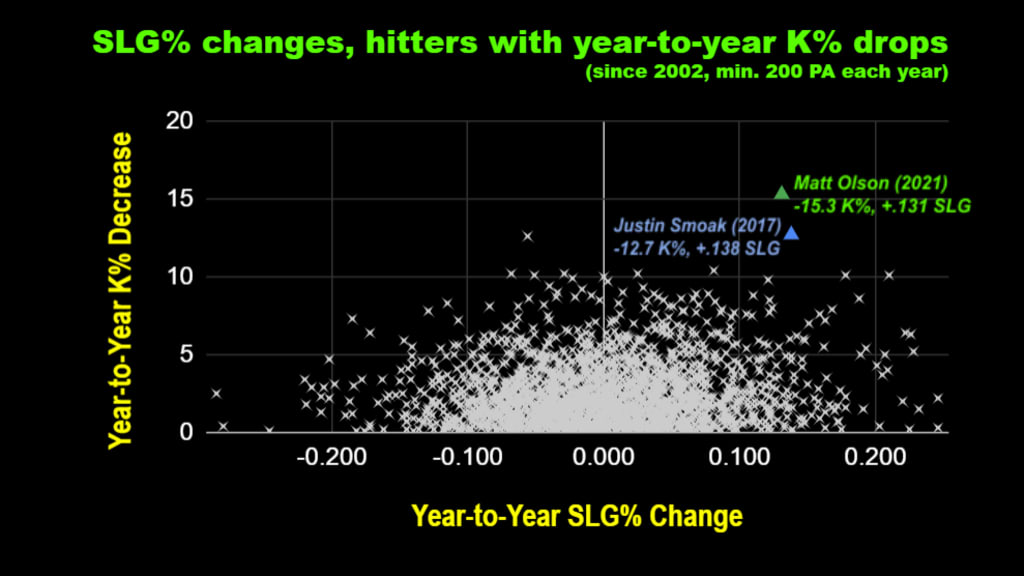Matt Olson is enjoying a year worthy of an American League MVP Award, if this weren’t the year where a couple guys named Shohei and Vladimir were doing their thing. But there is one area where Olson is standing head and shoulders above everyone -- not just in 2021, but across the last 20 seasons.
A’s fans know that few swings look more destined to crush a baseball than Olson’s beautiful, looping, left-handed stroke. They also grew accustomed to the side effect of that swing -- plenty of whiffs. Always near the higher end of the strikeout spectrum, Olson’s punchouts grew to an out-of-hand 31.4% of his plate appearances in a wayward 2020, ninth highest among qualified hitters.
Olson tinkered with that famous swing last winter (as documented extensively by The Athletic's Alex Coffey) and joined the growing wave of hitters turning to high-speed pitching machines for batting practice. The result? Olson didn’t just cut down that strikeout rate; he’s nearly sliced it in half, all the way down to a 16.1% mark entering Friday. In the span of a year, Olson went from the ninth percentile among qualifiers in strikeout rate to the 83rd percentile. Looking at the last 20 seasons (from the slow comedown of the Steroid Era through MLB’s strikeout surge), Olson owns the largest K% drop.
Largest year-to-year decrease in K%, last 20 seasons
Min. 200 PA in each season (4,783 player seasons)
1) Matt Olson (2020-21): -15.3%
2) Justin Smoak (2016-17): -12.7%
3) Austin Riley (2019-20): -12.6%
4) Felipe Lopez (2004-05): -10.4%
5-T) Aaron Hicks (2019-20): -10.2%
5-T) David Ortiz (2010-11): -10.2%
5-T) Cody Ross (2012-13): -10.2%
Here’s what’s even more fascinating about Olson, though -- cutting down strikeouts is great, but generally power hitters will live with some empty swings. Big cuts are how they bring value to their clubs, and trading off too much of that pop just to put the ball in play defeats the purpose. Olson, however, is living in the best of both worlds: He’s accompanied that strikeout dip with a major slugging increase, from a pedestrian .424 in 2020 to a more Olson-esque .555 entering Friday.
Looking again at that sample going back to 2002, Olson is almost by himself in how he’s added both contact and power in one fell swoop.

That’s a sample of more than 2,200 hitters that decreased their strikeout rate by at least one decimal point from one year to the next. Olson, by virtue of a double-digit K% dip and 100-plus point slugging increase, is in a club of two.
Justin Smoak was, similar to Olson, a big-whiff slugger for much of his career. He carried a career .223 average and had never clubbed more than 20 homers in any of his first seven seasons before he exploded for the 2017 Blue Jays, belting 38 round-trippers and earning his lone All-Star Game selection. He didn’t match that season again and also didn’t cut his punchout rate as much as Olson has, illustrating how hard it is to do what Oakland’s big man is doing.
Olson is routinely one of the hardest-hitting swingers, ranking among the game’s top 20% in average exit velocity, hard-hit rate and barrel rate (percentage of batted balls struck with the most powerful in-the-air contact) in each of his four full seasons. With fewer empty trips back to the dugout, he’s giving himself more chances to rip. This Matt Olson is essentially an improved v2 of the Olson that belted 36 homers in 2019 -- with more on-base ability.
Olson, 2019: 127 G, 36 HR, 25.2% K rate, 9.3% BB rate, 135 wRC+
Olson, 2021: 122 G, 32 HR, 16.1% K rate, 12.1% BB rate, 153 wRC+
As dangerous as Olson is at clubbing balls to the right-field seats, he’s also become less pull-happy. Olson has seen a shift in roughly 92% of his plate appearances (a rate topped by only three full-time hitters), but a more all-fields approach has helped him neutralize the strategy.
Olson vs. shifts, 2020-21
2020: 88.8% of PA, .283 wOBA vs. infield shift
2021: 92.2% of PA, .390 wOBA vs. infield shift
MLB avg. wOBA vs. infield shift: .323
Olson is striking out way less, going the other way more, and somehow enjoying the best full season, power-wise, of his career. It’s a resurgent season the A’s really needed, particularly while Matt Chapman and the rest of the offense struggled before Oakland acquired Starling Marte at the Trade Deadline. And as the A’s find themselves in a five-way battle for two AL Wild Card spots, they’ll need every single Olson tater down the stretch.
